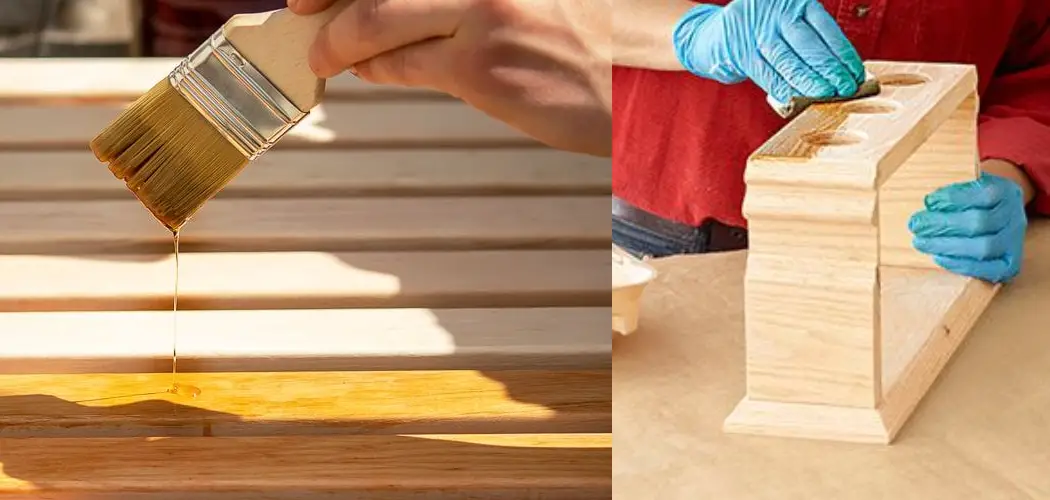Many people rely on gel stains for the best results when it comes to staining furniture. However, mistakes with this type of stain can be difficult to fix. In this blog post, we will go over some methods of how to fix gel stain mistakes. So whether your project has gone too dark or you’ve managed to create a blotchy finish, we have the tips you need to get your piece looking its best. So read on and get started on fixing those pesky gel stain mistakes.
Summary: If your gel stain is turning brown, there are a few things you can do to fix the problem. First, try to remove any dry or dusty surfaces that may be contributing to the color change. Second, make sure that the stain is completely wet before applying your stain remover. Third, use light pressure and movable strokes when cleaning the stain to avoid rubbing off the color. Finally, wait several minutes after cleaning the stain before applying a new coat of gel stain.
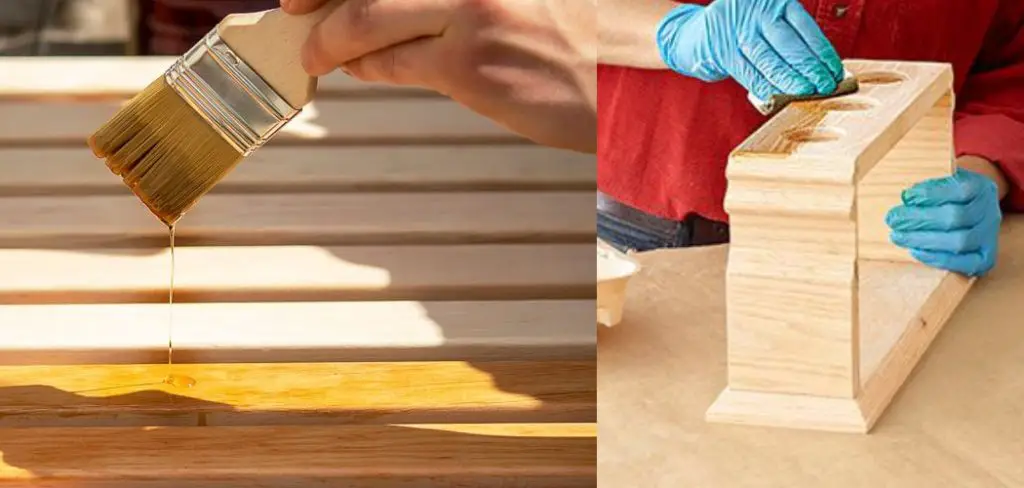
What Is Gel Stain?
Gel stain is a type of pigmented finish that can be used to give wood furniture a beautiful, deep color. This type of stain is perfect for those who want a professional-looking finish without dealing with the mess and fumes associated with traditional oil-based stains. Gel stains are available in a variety of colors, so you can easily find one that will complement your project. If you’re looking for a stain that is easy to use and will give great results, gel stain is the way to go.
Common Gel Stain Mistakes:
1. Applying Gel Stain Too Thick
The biggest mistake people make when using gel stain is applying it too thick. When applied correctly, the gel stain should be thin and even. If you apply the stain too thick, it will take forever to dry and will give your project a blotchy finish. If you find that you have applied the gel stain too thick, simply wipe away the excess with a clean rag.
2. Not Removing Excess Gel Stain
Another mistake people make is not removing the excess gel stain from their project. When gel stain dries, it will be much darker than it looks when wet. This is why removing any excess gel stain before it dries is important. Otherwise, your project will be too dark.
3. Applying Gel Stain Incorrectly
When applying gel stain, you want to make sure that you are doing it correctly. If you don’t, you could end up with an uneven finish or, worse, a sticky mess. If you are unsure how to apply gel stain, consult a professional or read the instructions with the product.
4. Letting Gel Stain Dry Before Wiping Off Excess
One of the most common gel stain mistakes is letting the stain dry before wiping off the excess. Letting the gel stain dry before wiping off the excess will be much harder to remove. It would be best if you always wiped off the excess gel stain before it has a chance to dry.
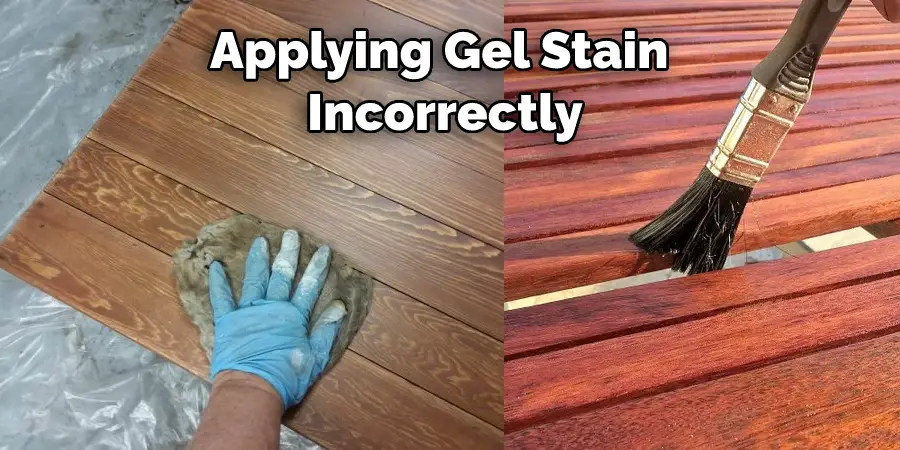
5. Not Sanding Before Applying Gel Stain
Another mistake people make is not sanding their project before applying gel stain. Sanding your project will help to create a smooth surface for the gel stain to adhere to. If you don’t sand your project before applying gel stain, the finish will be uneven and blotchy.
6. Applying Gel Stain Over a Un Primed or Unsealed Surface
If you try to apply gel stain over an unprimed or unsealed surface, the stain will not adhere properly and will likely chip or peel off. Gel stain needs a porous surface to adhere properly, so if you’re working with a non-porous surface like glass or metal, you’ll need to apply a primer or sealer first. Once the primer or sealer is dry, you can proceed with applying the gel stain as normal.
7. Not Applying a Top Coat After Staining
Once you’ve applied gel stain to your project, it’s important to protect the finish by applying a top coat. A top coat will seal in the stain and prevent it from fading, chipping, or peeling. It will also make the surface easier to clean and maintain. Without a top coat, gel stain is susceptible to water, heat, and sunlight damage. So if you want your gel-stained project to last, be sure to apply a top coat after staining.
Types of Gel Stain
There are many different types of top coats available, so you’ll need to choose one that is compatible with the type of gel stain you’re using. The most common types of top coats are polyurethane, lacquer, and shellac.
Polyurethane:
Polyurethane is a durable top coat that will protect your gel stain from water, heat, and sunlight. It is available in both water-based and oil-based formulas. Polyurethane is easy to apply and will give your project a high-gloss finish.
Lacquer:
Lacquer is a durable top coat that is available in both water-based and oil-based formulas. It dries quickly and will give your project a high-gloss finish.
Shellac:
Shellac is a durable protective coating. It is used in many products, including lacquer, varnish, and sealant. Shellac is available in both water-based and alcohol-based formulas. Shellac dries quickly and will give your project a high-gloss finish.
You Can Check It Out to Fix Chew Marks on Wood
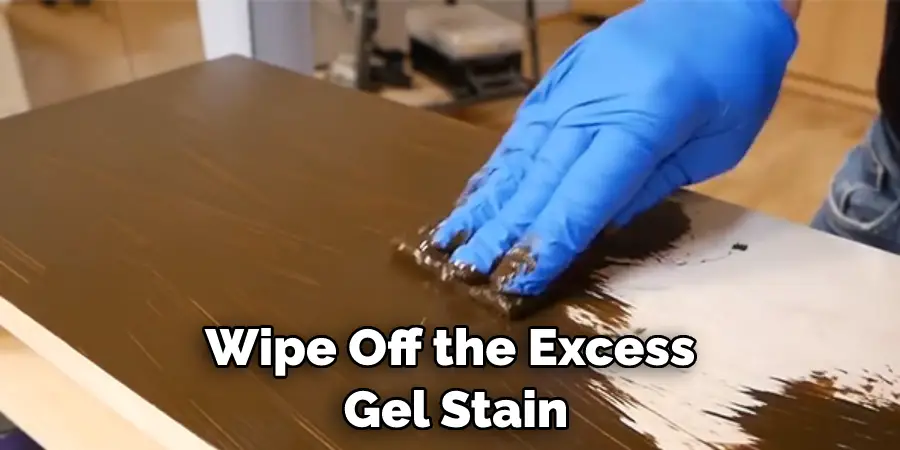
Step by Step How to Fix Gel Stain Mistakes:
1. Remove the Excess Gel Stain
If you accidentally applied too much gel stain, remove the excess using a clean cloth before it dries. You also can do this by wiping it off with a rag. First, wet the rag with mineral spirits or paint thinner. Then, gently wipe off the excess gel stain. Make sure to remove all of the gel stains before it has a chance to dry.
2. Sand the Surface
If you accidentally applied gel stain to a non-porous surface, sand the surface before proceeding. This will create a rougher surface for the gel stain to adhere to. You can use a hand sander, power sander, or sandpaper to do this. Start with coarse sandpaper and work your way up to a finer one. Sanding the surface will also help remove any streaks or smears left behind.
3. Apply Gel Stain Evenly to Your Project.
If you accidentally applied gel stain unevenly, you can even out the finish by applying a second coat. Make sure to apply the gel stain evenly and in the same direction as the first coat. You also want to make sure that the second coat is thin and even. Applying too much gel stain will make it difficult to even out the finish. You can use a brush, cloth, or spray bottle to apply the gel stain. Just make sure that you’re working in a well-ventilated area.
4. Wipe Off the Excess Gel Stain.
If you accidentally left a gel stain on for too long, you can remove the excess by wiping it off with a clean cloth. You can also do this with a clean rag. First, wet the rag with water. Then, wipe off the gel stain in a circular motion. Be sure to apply pressure as you wipe. This will help remove the gel stain from the surface of your furniture.
5. Let the Gel Stain Dry.
If you accidentally left gel stain on for too long, you may need to let it dry before proceeding. Gel stain can take anywhere from 2 to 24 hours to dry. Once it’s dry, you can apply a top coat if desired. Use a hair dryer to speed up the process if you’re in a hurry. If you’re unhappy with how the gel stain looks after it’s dry, you can always apply another coat. Just be sure to let the piece dry completely before applying a second coat.
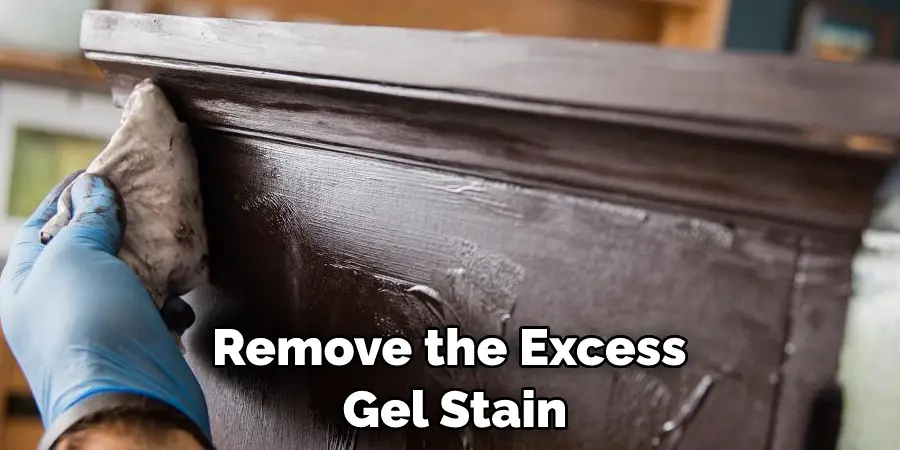
6. Apply a Top Coat.
You’ll need to apply a top coat if you accidentally applied gel stain to a non-porous surface. This will protect the gel stain from wear and tear. Top coats also help to seal in color and prevent fading. There are many different types of top coats available on the market.
You can use a polyurethane, lacquer, or varnish. Make sure to read the instructions on the top coat before applying it. Next, apply the top coat in thin, even coats. Allow each coat to dry completely before applying the next one.
Tips and Warnings on How to Fix Gel Stain Mistakes
Tips:
- Applying a top coat can help to even out the color and give the piece a more finished look.
- If you are not happy with the results of your staining, you can always paint over it with a different color.
- Be sure to test the gel stain on a small area before applying it to your entire project.
Warnings:
- Be sure to follow the manufacturer’s instructions when using gel stain.
- Gel stain can be difficult to remove, so be careful when applying it.
- Gel stain can sometimes cause wood to warp or crack, so be sure to test it on a small area before using it on your entire project.
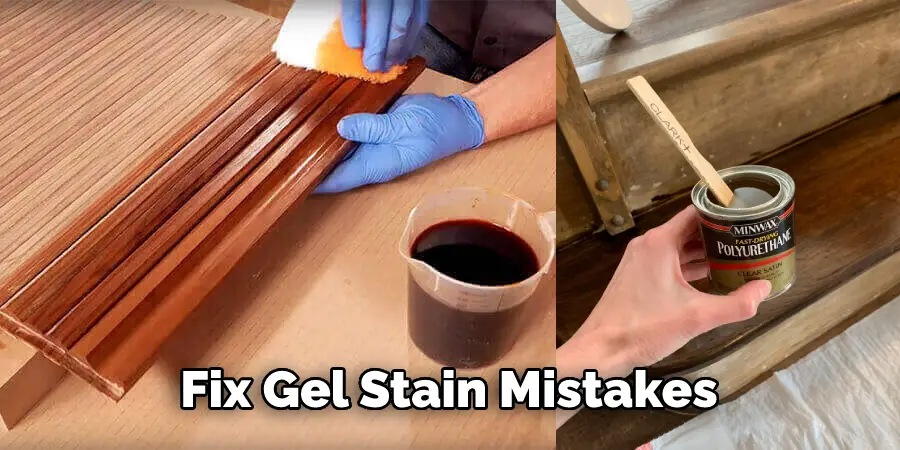
Can You Thin Gel Stain With Mineral Spirits?
Yes, you can thin gel stains with mineral spirits. Gel stain is a thick and viscous type of stain that is used to achieve a unique hand-rubbed finish on wood surfaces. It can be a bit challenging to apply compared to regular stain because of its consistency, but thinning it with mineral spirits can make it easier to work with.
When using mineral spirits to thin the gel stain, it’s important to follow the right ratio to ensure that you don’t end up with a runny mixture that won’t adhere properly to the wood surface. The general recommendation is to add no more than 10% of mineral spirits to the gel stain.
This will help to reduce its thickness and make it easier to apply. Once you have mixed the gel stain and mineral spirits, you can apply it to the wood surface using a brush or cloth and then wipe off any excess stain with a clean cloth. It’s important to follow the manufacturer’s instructions and safety guidelines when working with mineral spirits and gel stains.
Can You Leave Gel Stain on Without Wiping?
Technically, you can leave gel stains on without wiping it off, but it is not recommended. Gel stains are designed to be applied and wiped off because they are thicker and have a higher viscosity compared to traditional oil-based stains. This creates a more even finish and helps prevent blotching and streaking.
If you leave gel stain on without wiping, you risk uneven color and a tacky or sticky finish. Additionally, any excess stain left on the surface can attract dust and dirt, which will detract from the overall appearance. Always follow the manufacturer’s instructions and wipe off any excess stain after applying to achieve the best results when using gel stain. This will ensure a beautiful, even finish that will last for years to come.
What Happens if You Stain Over Stain?
Staining over an existing stain can have various results, depending on the type of stain, the type of wood, and the condition of the existing stain. Generally speaking, staining over the stain will not produce the same results as staining on bare wood. If the existing stain is in good condition with no signs of damage, you may be able to apply a new coat of stain directly over the old one.
However, if the existing stain is damaged, peeling, or flaking, it’s important to remove it before applying a new coat of stain. This is because the new stain may not be able to adhere properly to the surface, resulting in an uneven or blotchy appearance. Furthermore, if the new stain is darker than the existing stain, it may not cover the old color entirely, resulting in an uneven color tone.
Conclusion
So, now you know how to fix gel stain mistakes. The next time you tackle a project with this versatile product, keep these tips in mind. With a little practice, you’ll be able to apply gel stain like a pro and achieve the beautiful results you desire. Have any questions? Leave us a comment below!

